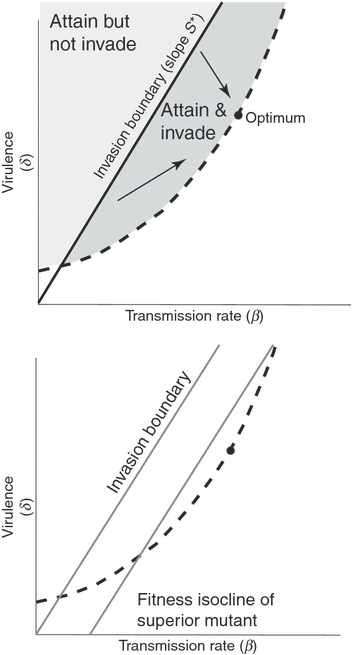Figure 2.

Invasion criteria. (Top) Highly virulent parasites can invade high host densities even though their virulence is far from optimal. Conditions for the invasion of a host population of density S* by a parasite with parameters (δ, β) are S* > δ/β, where δ is virulence and β is the transmission rate. Points satisfying S* = δ/β lie a line radiating from the origin (of slope S*), so radii with progressively higher slopes represent parasite parameters that can invade only at progressively higher host densities. All parasites whose values fall in the darker shaded region below the line of slope S* and above the dashed trade-off boundary are attainable and can invade, whereas the light-shaded region above the invasion boundary represents values that the parasite can attain but do not allow invasion (for host density S*). The parasite population would eventually evolve toward the dot on the trade-off boundary (arrows), but it could create a potentially highly virulent epidemic from the start of the invasion until the evolutionarily equilibrium virulence was attained. (Bottom) Evolution following invasion may be slow to approach optimal virulence. The rightmost oblique line is a fitness isocline (of slope S*), and all points on it have equal fitness, superior to the fitnesses of all points to its left. Evolution would tend to move parasites progressively toward right-most isoclines, but as a mutant’s relative position on the fitness isocline does not affect its fitness, evolution at each step could move virulence further or closer to the optimum (solid point) until the optimum was approached closely. The input of mutations (or genetic covariance between transmission and virulence) thus has a major impact on the evolution of virulence in these early stages (Day and Gandon 2007). Improved fitness need not greatly restrict the range of virulence values allowed, and indeed, virulence could evolve to deviate further from its optimum during intermediate stages of the adaptation. These arguments apply to constant host density, and if susceptible host density is declining, the fitness isoclines will have progressively shallower slopes.
